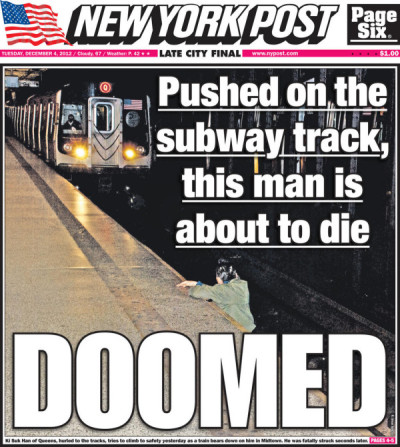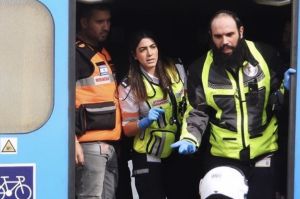Subway Death Photo Sparks Debate About Photographer's Moral Obligation
R. Umar Abbasi Accused of Failing to Help Ki Suk Han in Path of Oncoming Train

A recent controversy regarding a photo of a man about to be hit by a New York City subway car has critics questioning the moral obligation of the photographer who took the picture, suggesting that perhaps he should have stepped in to help the victim instead of snapping a photo.
On Monday, Dec. 3, 58-year-old Ki Suk Han, of Queens, New York, was struck by a subway train at the Times Square station while journalist R. Umar Abbasi of the New York Post snapped photos of the victim while he unsuccessfully struggled to get off the tracks.
The photo's appearance on the cover of the Tuesday edition of the New York Post, a daily newspaper, has initiated a heated ethics debate regarding the journalist's moral obligation to help the victim, instead of taking his photo.
Many critical of Abbasi's actions took to Twitter to express their disgust.
"The photog should be arrested. He should have helped him," tweeted Matt Jordan regarding the incident.
"Disgusting! Whatever happened to integrity? Or just basic morals?" tweeted Natasha Henry.
Additionally, hosts of NBC's "Today" show, Al Roker and Matt Lauer, agreed the photograph was "alarming" and more should have been done to help the victim.
"Somebody's taking that picture. Why aren't they helping this guy?" Roker questioned his co-hosts while viewing the photo on the Tuesday episode of the "Today" show.
Soledad O'Brien of CNN took to Twitter to express her opinion of the photo, writing: "I think it's terribly disturbing – imagine if that were your father or brother."
The photographer, Abbasi, explained his actions in a feature published in Wednesday's New York Post, arguing that he was attempting to alert the driver of the train with the flash of his camera.
"I just started running. I had my camera up – it wasn't even set to the right settings – and I just kept shooting and flashing, hoping the train driver would see something and be able to stop," Abbasi wrote.
"I had no idea what I was shooting. I'm not even sure it was registering with me what was happening. I was just looking at that train coming," the freelance photographer wrote, adding that even if he had not been taking the photo, he would have not had enough time to get to Han.
Although Abbasi is receiving a large amount of criticism for his photograph, others argue that judgment of the photographer is unwarranted, as there are many factors to take into consideration.
"What was done was not necessarily unethical," Kenny Irby, who specializes in ethics of visual journalism at Florida's Poynter Institute, told The Associated Press.
"It depends on the individual at the time of action," Irby added, arguing that Abbasi's distance from the victim and his ability to lift the victim must be taken into consideration.
Additionally, John Long of the National Press Photographers Association (NPPA), told AP that he cannot pass judgment on Abbasi because he was not there.
"I cannot judge the man. I don't know how far away he was; I don't know if he could've done anything," said Long, who is chairman of the ethics committee at the NPPA.
Jonathan Turley, a law professor at George Washington University and an expert in broadcast and print journalism, wrote in his Dec. 5 blog entry that there exists a blurry line between one's moral obligation to help and one's legal obligation to help in regard to the "no duty to rescue" rule.
According to Turley, the "no duty to rescue" rule provides misdemeanor punishments to onlookers who do not assist a victim in a tragedy, although the rule is rarely enforced.
As Turley contends, he would be "very skeptical about the enforceability of such laws in most situations as a criminal matter," especially because the alleged suspect who pushed Han onto the tracks in Monday's tragedy has reportedly implicated himself to New York City police.
"[The suspect] will obviously face judgment after we determine his competency," Turley wrote.
However, Turley argues that although legal discourse will likely not be taken against Abbasi, "it is the judgment of the onlookers that should occupy New York in the coming weeks."





























